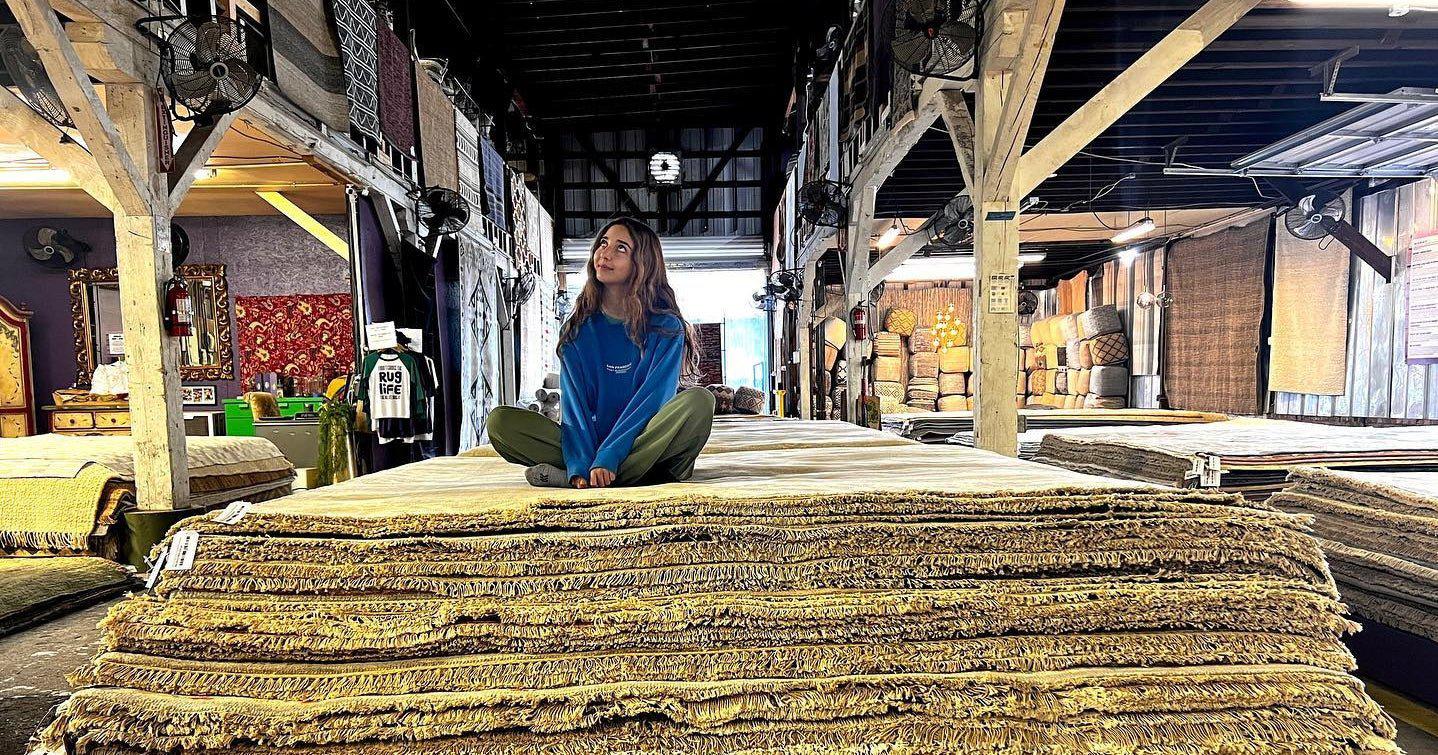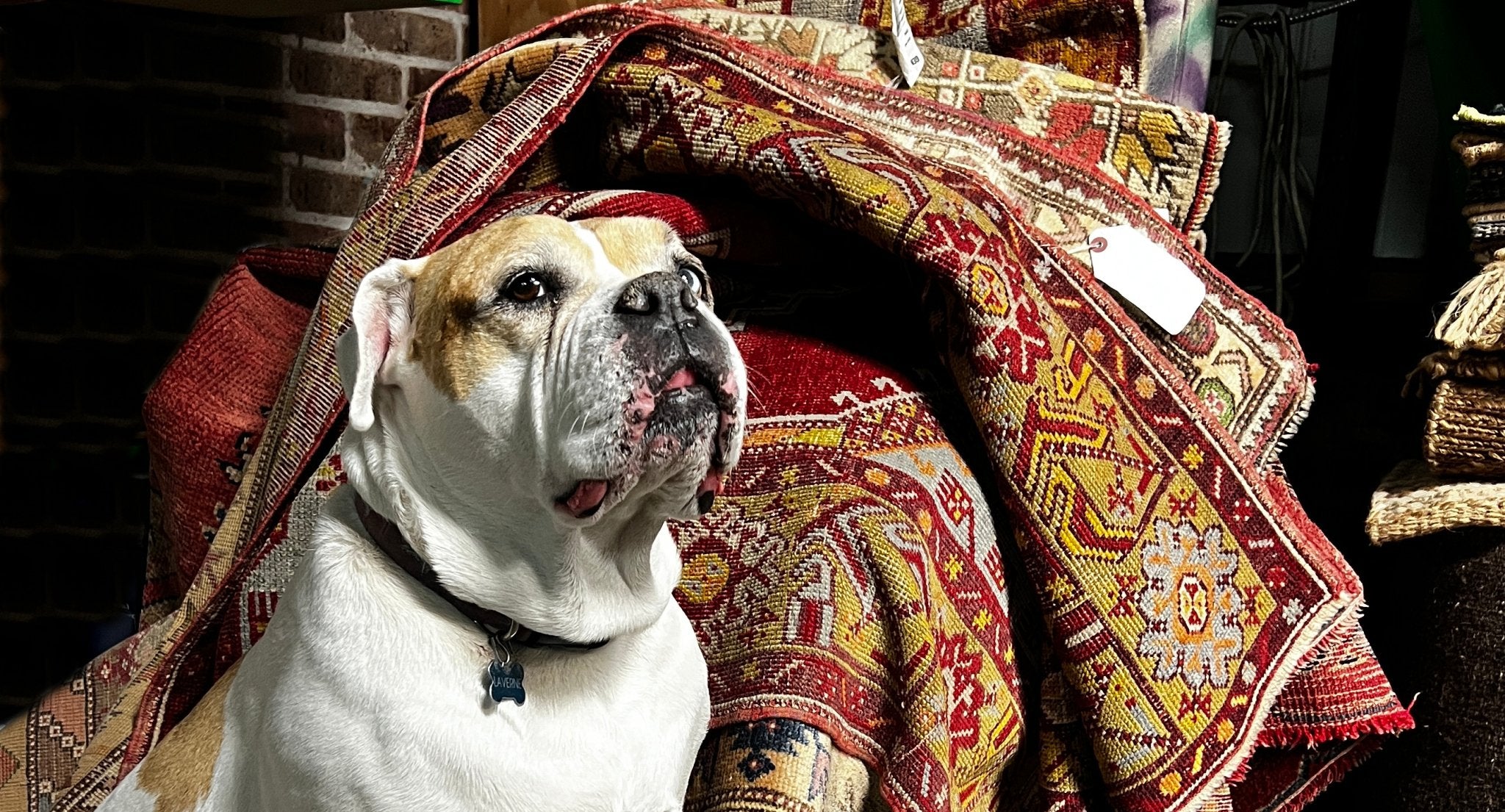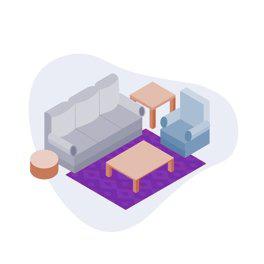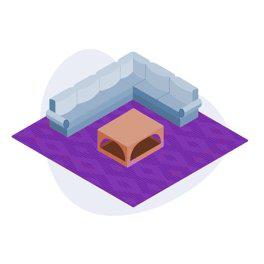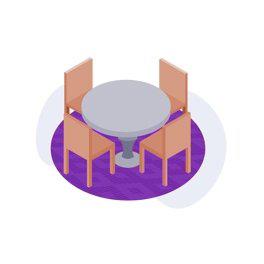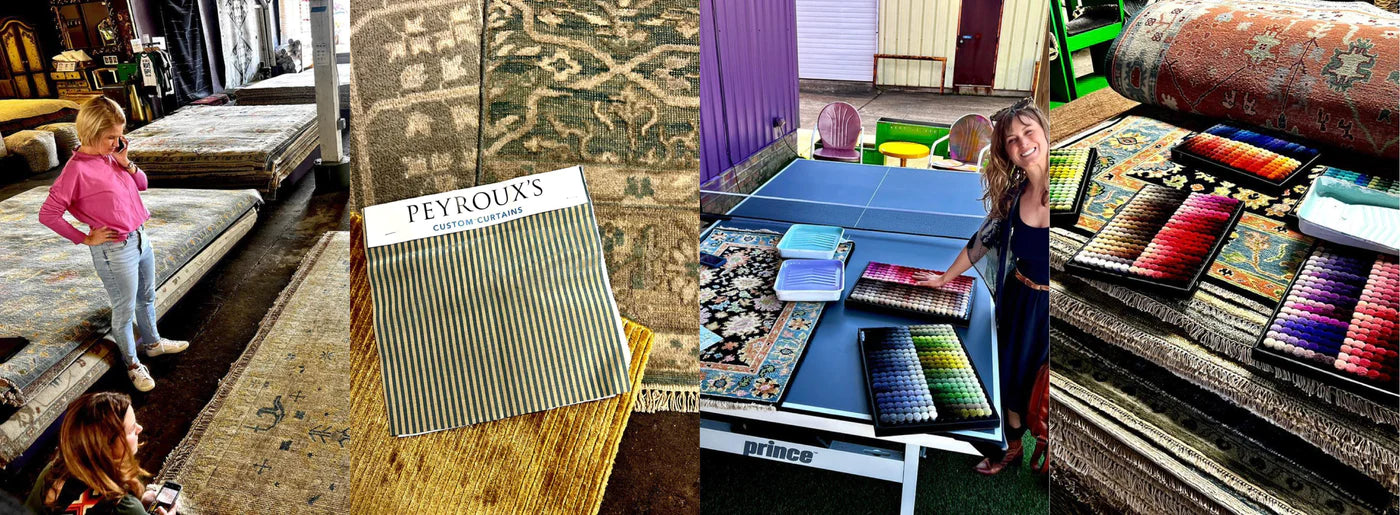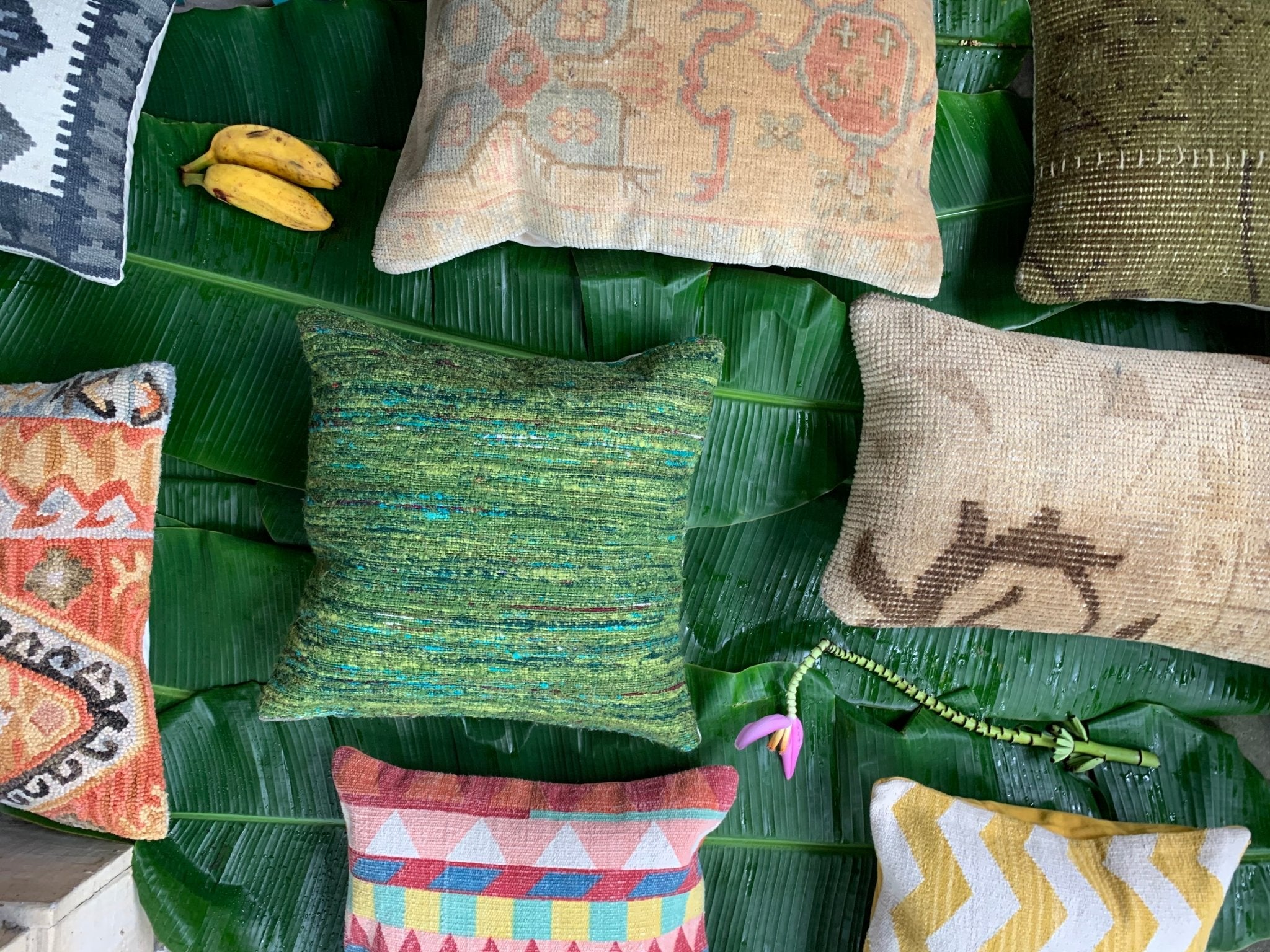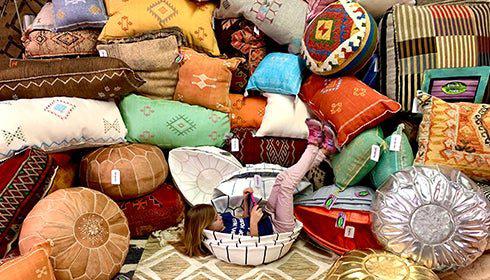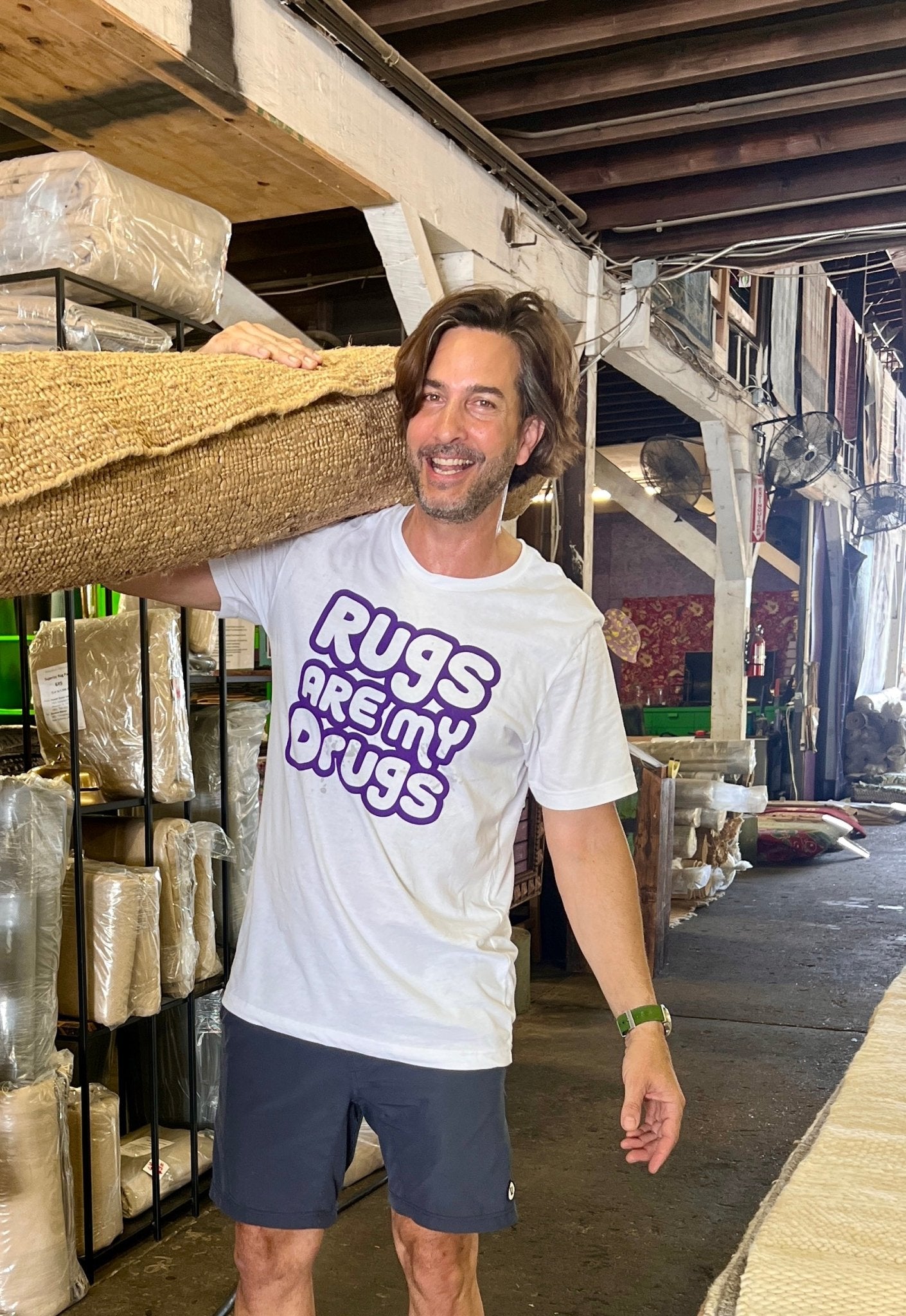Menu
Banana Manor FAQ
ARE ALL YOUR CARPETS HAND MADE?
Yes. All of our carpets are entirely hand knotted and hand woven in the same manner as they have been made for thousands of years.
WHAT IS A KILIM?
A “Kilim” (sometimes called “gelim”) is a flat-woven Oriental rug, made much like Navajo rugs, without pile. These are also hand woven in wool fibers. They don’t generally last as long in floor use as the thicker knotted pile carpets (perhaps an average of about 25 years compared to 50-80 years of use for a hand knotted pile carpet) and they cost considerably less. Kilims have traditionally been woven in all the major rug weaving countries such as Turkey, Iran, Afghanistan as well as North Africa. In India, flat woven kilims are called durries. Kilims tend to have a more graphic look and an informal feel. I personally really love kilims because they were often not woven for commercial export. They tend to retain the oldest and most traditional designs/colors and an authentic/archaic sensibility. Although, we also offer new kilims with wonderful contemporary and minimalist designs.
ARE FINELY KNOTTED RUGS BETTER THAN OTHERS
No… not really. A rug that is more finely woven (with more knots per inch or KPI) is not necessarily a better rug. A finer weave allows for more detail and smaller designs. Curved lines in a rug’s design can be “drawn” more smoothly and gracefully in a rug with many knots per square inch. It is the same thing as pixels in a picture. More pixels in an image allow for more detail and clarity. But it must be said that fine knotting alone does not make a rug good. I have seen many finely woven yet unattractive rugs. Also, a fine weave simply is not appropriate in certain kinds of informal tribal or village rugs. It is more important to consider each rug individually. When judging a rug, the overall qualitative nature of the materials, the workmanship and the balance of designs/colors are more important than the easily quantifiable KPI.
HOW DO I CARE FOR MY HAND KNOTTED WOOL RUG?
People think that because Hand Knotted Wool rugs are valuable, they must be pampered like fine China. But they have earned their reputation of being magical in part because of their sheer endurance. When dirty, they can be washed. If they are broken, they can be repaired or re-woven. Their dyes resist fading and running and their wool, full of natural oils (lanolin) keeps many potential stains from penetrating and setting. There are, however, some ways to maintain and protect your rug.
Our rugs are resistant to sunlight. They tend to mellow softy over time and develop a soft and warm patina. Nevertheless, direct and prolonged exposure to sunlight will fade your rug. If your rug is in a very sunny room, it is best to occasionally rotate it so that its UV exposure will be minimized. Also, think about using blinds or shades. If you have old windows that are not double-paned, there are UV protective coatings that can be applied. These filters block many of the harmful UVs while not changing the quality of light. Nevertheless, your rug can withstand a normal amount of sunlight exposure without any noticeable effects.
Vacuum your rug regularly. Contrary to what some people think, vacuuming your rug is not harmful. It is the dirt that is trapped inside a rug’s pile that can lead to premature wear. Some of todays vacuum cleaners are made for industrial carpets and have a very aggressive “powerhead” or “beater bar”. If this is the case, set the vacuum powerhead on a setting for thick carpeting or use only the suction attachment without the powerhead. Also, be careful of the fringe when you vacuum or even better, vacuum side-to-side to avoid the fringe. You may also broom your rug. Once a year, flip your rug upside-down and vacuum the underside of the carpet to remove dirt that works it’s way deeply into the pile and vacuum the floor under the rug too if it is dirty. This trapped dirt can be abrasive to the rug fibers. It is not recommended to beat your rug as this may break some of the fibers.
Rotate your rug (ie: turn in 180 degrees) occasionally. I usually rotate my living room rug once a year. This keeps wear patterns from forming in a rug that may get uneven use. Also, if you have windows on one wall, rotating a rug exposes different areas to the sunlight. Just like rotating the tires on your car, rotating your rug promotes a more even and uniform pattern of wear.
Water will not harm your rug. But in order to avoid mildew it is best to thoroughly dry damp areas within 24 hours. And watch-out for the potted plant! Do not place a potted plant directly on your rug. Be sure to use a plant stand. The dampness from a potted plant can become trapped between the pot and the carpet. In time, this can rot your carpet and create a perfectly round pot-sized hole in your rug.
WHAT DO I DO ABOUT SPILLS AND OTHER ACCIDENTS?
Don’t panic. Most promptly treated spills are easily removed and do not leave permanent stains. The best medicine for spills is to get the substance out of the rug as fast as possible. If you spill an organic substance, use a paper towel or cloth. If the stain is an oil or a dense substance, use a spoon to scoop up as much as possible off first. Contrary to some common belief, pouring salt on a stain doesn’t do much of anything. After cleaning up the spill, dilute it with some water (or club soda is great too if you have it). Blot-Rinse-Blot…repeat. If the rug’s dyes are bleeding or being transferred to your rag, STOP! Your rug should be handled by an expert who can take extra steps to stabilize these dyes.
Remember… blot at the stain. Do NOT scrub as this can un-twist and break the wool fibers. If the stain persists and the dyes are stable, use more water. You could also use a few drops of dish washing soap diluted in water to create a very mild detergent. When you remove the stain, be sure to prop up the wet section of the rug so that it can dry thoroughly. Use a house-fan if needed to circulate air to help dry the wet area. It is not good to let a rug remain wet for more than a day as it may mildew. Still no luck? If the stain persists, bring it to a professional rug cleaner who deals with Oriental rugs. We suggest that you do not use chemical cleaners, “steam” cleaners or rug “shampoos” that are formulated for synthetic fibers and might damage your rug.
Pet stains and pet urine can be more troublesome if not treated immediately since they can cause permanent discoloration. Again: First remove as much of the foreign substance as possible with a paper towel or rag. Then, it is recommended to use a solution of white vinegar mixed with water to rinse the stain. Blot-Rinse-Repeat. The white vinegar will lessen dye bleed risk and will help to blot away the acidic pet stain. If you use a commercial “enzyme” cleaner formulated for pet accidents keep in mind that some are better than others…. If you do use one of these cleaners, it is suggested that you subsequently use a water-white vinegar solution as a final rinse to remove the “enzyme” cleaner. Again, be sure to dry any damp areas thoroughly. With pet stains, after taking these immediate steps, I would suggest also using a professional rug washer to thoroughly clean your rug. Additionally, ask your rug washer to wash AND deodorize your rug to remove any possible odors.
For non-organic stains (such as dyes or chemicals), it would be best to bring the rug immediately to a professional Oriental rug washer.
As a final word, rest assured that most accidents and spills will not harm your rug. And to be sure that your cleaning efforts do not harm the rug either… keep these steps in mind: blot rather than scrub, no chemical cleaners, and if you use soap, use only a couple of drops. Also, after you clean your stain as described, be sure to dry the area thoroughly to prevent mildew. And when in doubt, bring your rug to a professional Oriental rug washer.
HOW DO I MEASUE FOR A RUG?
You will need a tape measure, a pen, and painters tape. First, move furniture, if needed and place the painters tape along the area where you would like a rug to be placed. Your taped area should be the entire width and length of the desired rug which will include all four sides. With your measuring tape, measure the size of the area you have taped and use your pen to write down dimensions on the tape. This will help you determine the approximate size rug needed for your space and can help narrow your search!
Helpful hint: consider running your rug parallel with your room or with the longest piece of furniture in your space.
HOW MUCH SHOULD I SPEND?
Rugs are an investment and it’s important to know what kind of investment you are able to make. When thinking about your budget it’s crucial that you understand what influences the price of an area rug. These factors include material, complexity of design, number of colors used, dying technique, knot count, and age and condition if it is an antique rug. Our rugs are meant to last a lifetime with proper care and cleaning.
We offer finance options through Klarna. You will find the option at check out or you can email info@lilliekatrugs.com for more details.
HOW IMPORTANT IS DURABILITY?
If you have children, pets or you’re placing an area rug in a high traffic area, durability is important. How well a carpet stands up to wear and how tolerant it is to cleaning and maintenance, are important indicators of quality. Handmade rugs, especially ones made of wool are known for durability.
WHAT IS THE BEST FIBER TO HAVE IN AN AREA RUG?
One cannot beat wool for wearability, that is, a good quality wool rug. The consumers' lifestyle in their home plays a large role when selecting the proper rug with regards to fiber content.
WHAT DO I DO IF MY DOG GETS MUD ON MY NEW AREA RUG?
Resisting the urge to clean mud is difficult. Mud should be dry before trying to remove it. After the solid is removed with a blunt object like a spoon, then depending on the fiber, the proper liquid can be used to remove any left over stain caused by mud.
SHOULD I HAVE MY AREA RUG PROFESSIONALLY CLEANED?
We recommend having your rugs cleaned only when it is needed. If your rug gets heavy use, cleaning once a year is fine. Average wear and tear necessitates a professional cleaning only once every 2-3 years. Regular vacuuming is recommended to keep your rug in the best shape possible.
WHAT SIZE IS RIGHT FOR YOU?
Typically, you want an area rug that is big enough to put the front legs of your furniture on the rug or one that is big enough to completely put your furniture on it. However there are no hard and fast rules about what size is perfect for your space! However, choosing the right size is essential because a rug that is too small can make a room feel uninviting and a rug that is too big can make a room feel smaller. To get it right, consider taping off the area with painters tape to get a feel of the size you want. From there, you can measure the different sizes you have taped off to better help you in your search.
WHAT SIZE RUG SHOULD GO UNDER A DINING ROOM TABLE?
We suggest the customer add 4' to the width and length of their table, which will give a 2' perimeter of area rug out from the table which will allow all 4 chair legs to be on the rug while the person is seated. Smaller frame people can do with 18," however 2' is the norm.
SHOULD AN AREA RUG BE A CERTAIN AMOUNT AWAY FROM THE WALL ALL THE WAY AROUND THE ROOM?
We are of the philosophy that the only rule that exists with rugs is the answer to the first question. Rugs define a space and should be the correct proportion to what is going on in that particular area.
DO I REALLY NEED A RUG PAD?
We recommend a rug pad, not only to provide additional cushion, but to protect the flooring beneath the rug from wear. Rug pads will also give your rug additional traction to prevent slipping, making your rug safer.
WHAT IS YOUR RETURN POLICY?
Our objective is to provide you the perfect rug for the space. If that means you need to swap out rugs 20 times and we eventually make one for you at our factory in India, then so be it. We will provide you the perfect rug!
- Choosing a selection results in a full page refresh.
